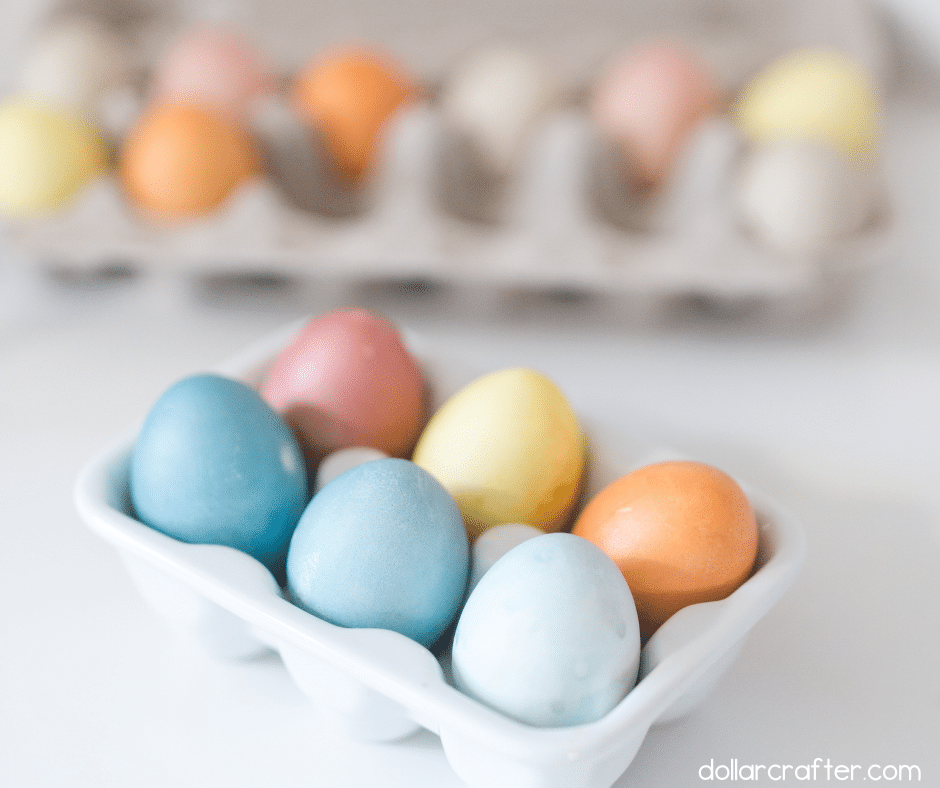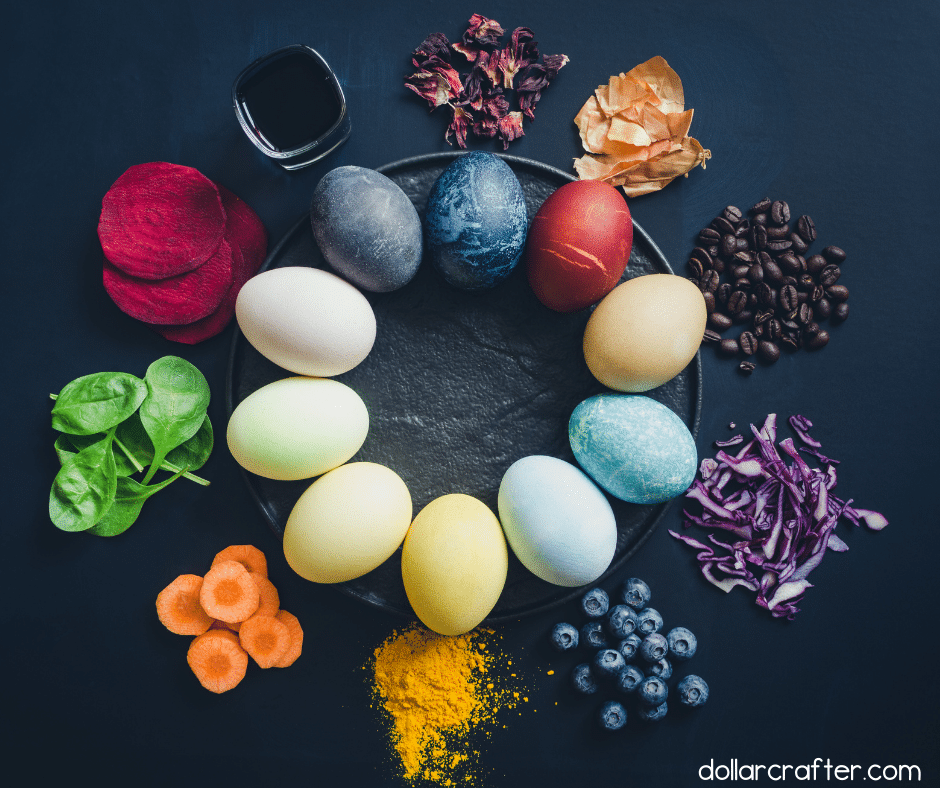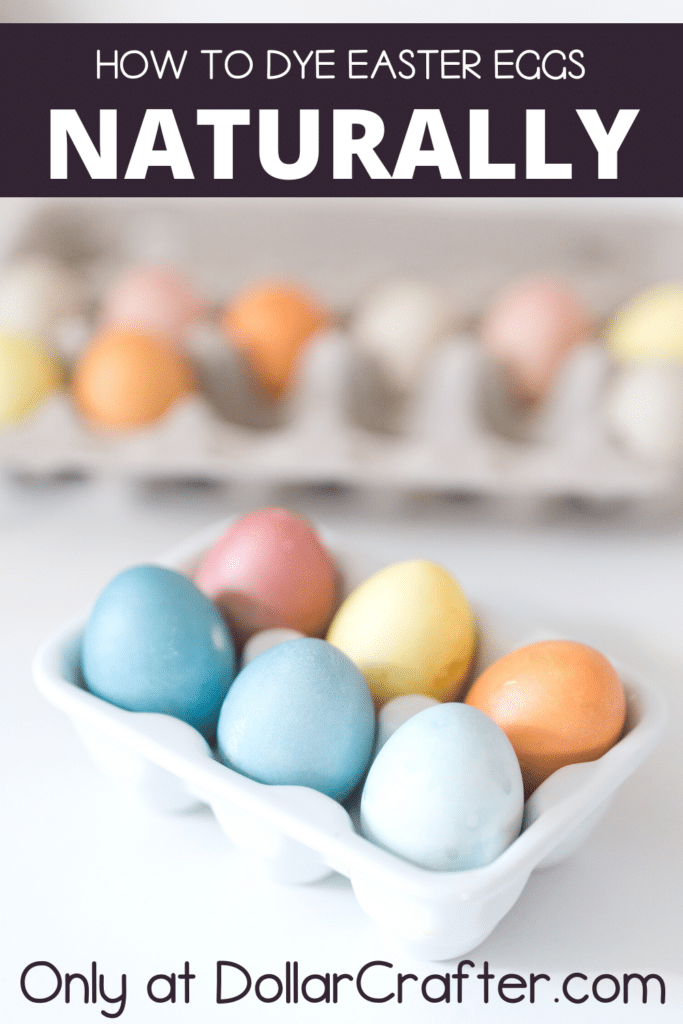Wondering how do you color Easter eggs without food coloring? Look no further than this guide! Here, we’ll show you how to easily create lovely hues to naturally dye Easter eggs using items you probably already have in your kitchen. With just a little bit of creativity, you can have the most unique Easter eggs on the block! Ready to get started? Let’s go!

Dyeing Easter eggs without store bought dyes or food dye is also a great activity to do with kids. You can perform all kinds of science experiments with length of time eggs stay in the dyes, which ingredients create the best colors, and how to mix ingredients to create unique colors.
How to Naturally Dye Easter Eggs
If you are naturally dyeing Easter eggs, there are two basic methods you can use – a hot bath or a cold bath.
In a hot bath, you boil the eggs at the same time as the dye. This method saves you time, but I actually prefer the cold bath to avoid overcooking the boiled eggs.
With a cold bath, you boil the eggs first and then place them into the natural dyes with vinegar. If you like to eat your eggs afterwards, I highly recommend the cold method as the eggs might be over-boiled using the hot bath. Feel free to experiment and see what works for you!
The basic process for naturally dyeing Easter eggs is to bring your ingredients to a boil (recipes below) and then let them simmer 20-30 minutes. Your eggs will come out a lighter color than the dye, so make sure they are full of color! Once your dye is the color you want, let it cool and add 1-2 tablespoons of vinegar per cup of dye. Then, add the eggs and let them soak to set the color.
Because you are using natural ingredients, the flavors can sometimes seep through the porous egg shell and affect the taste of your boiled egg. If you normally eat your dyed Easter eggs, this is something to keep in mind. You might want to choose less “potent” ingredients for your dyes or use them in egg salads where the added flavor will be less noticeable.
With naturally dyed eggs, you have more control over the vibrancy of your colors. In general, the longer you leave your eggs in the dye, the deeper the hues will be.
To get that lovely sheen when naturally dyeing Easter eggs, first let them dry, and then rub just a bit of food safe oil on them.
One more general note – if you are used to using rubber bands or drawing on your eggs with crayons for decorations – be sure to use the cold bath method. If you use the hot method, the rubber bands might disintegrate and the wax will melt, foiling your decorative pursuits.

What Can I Use to Dye Eggs Naturally?
You can use vegetables, flowers, spices, tea and even coffee to get those beautiful naturally dyed Easter Eggs. Below are specific ingredients and instructions for getting certain colors, ideas for decorating and answers to frequently asked questions.
How Do You Make PINK Egg Dye?
Boil 2 cups water, 2 cups shredded beets together. Let it simmer for 20-30 minutes until you have the desired shade of pink. Add 1-2 tablespoons of vinegar per cup of dye. Once cooled you can soak your boiled eggs in the dye.
Cranberries are another option for getting pinks.
How Do You Dye Eggs ORANGE?
Place 2 cups yellow onion skins in a pan. Cover the peels with water and boil together. Pro tip: If you start saving onion skins in advance you will have enough for dyeing your Easter Eggs. Just keep the dried skins in a bag or glass jar on your countertop.
How Do You Dye Eggs Naturally YELLOW?
To make a beautiful golden yellow, you will need 2 tablespoons turmeric, 2 cups of water and 1-2 tablespoons vinegar. Boil the turmeric and water together and simmer for 20 minutes until you have the perfect yellow. Add the 1-2 tablespoons of vinegar and let your dye cool. The longer you let it soak the more golden your results will be.
Some herbal teas, such as chamomile, will make a pale yellow.
How Can I Naturally Dye My Eggs BLUE?
I’ve gotten the best blue results using purple (red) cabbage. Put 2 cups of shredded red cabbage into a pan and cover the cabbage with water. Boil together. Once it is cool you can soak your eggs.
If you use brown eggs this will give a greenish hue.
Blueberries can also give a fun blue color.
How Do You Dye Natural PURPLE Eggs?
Just like we used yellow onion skins above to make the orange dyes, you can use red onion skins to make a lovely lavender for your naturally dyed eggs. You will need 2 cups red onion skins covered with water in a pan. Boil them together and then simmer. Once the dye is cooled, add your boiled eggs. You can also soak boiled eggs in red wine to get a purplish hue.
How Can I Naturally Dye My Eggs GREEN?
Spinach and parsley make a lovely spring green natural dye. Please Note: Vinegar washes the green color out of spinach so leave it out of this one! Take 2 cups of fresh spinach or parsley and simmer together with 2 cups of water. You will probably need to soak your eggs in the dye overnight to get a lovely light green.

Can I Dye Eggs with Tea?
Can you dye eggs with tea? Yes! Experiment with different teas. Chamomile, Red Zinger, hibiscus, ginger will all give you varying shades when naturally dyeing Easter eggs. Although it sounds counterintuitive, green tea has given me uninspired results – so I’d avoid that one.
Can Coffee Dye Eggs?
Yes, you can also use coffee to dye your Easter eggs. You will get a richer brown if you use strong coffee and let your eggs soak a few hours.
How Do You Mix Colors When Naturally Dyeing Eggs?
Remember all the way back to elementary school when you learned about primary and secondary colors? Those theories apply to natural dyes for your Easter eggs, too! If you dye an egg pink using beets, let it dry, and then dye it again in the yellow turmeric dye – you will get a more golden color (red+yellow=orange). Same will be true if you double dip blues/and greens; you will get a beautiful teal.
Why Use Natural Dye? Is Food Coloring Safe for Easter Eggs?
Remember those neon and glittery eggs you can make with a kit from the supermarket? If you crack open that egg you will see the dye has oftentimes soaked through to the egg. Even though the most popular brands are considered food safe, there is some research questioning the safety of certain food dyes (looking at you, Red #3).
A few studies have shown food dyes can increase behavior issues or irritability in kids. They may also negatively impact ADHD symptoms. Many dyes that are banned in Europe, for example, are allowed in the United States.
If we have so many wonderful, accessible options for naturally dyeing Easter eggs – why not? It’s fun to eggs-periment (I’ll show myself out) and you can rest easy knowing that the eggs are completely safe to eat.
Easy Ideas for Decorating Naturally Dyed Easter Eggs
Writing on the eggs with a white crayon or using rubber bands to make stripes in the dye will work with natural dyes for Easter eggs, too. Just make sure you are using the cold method. You can also apply foam stickers to the eggs prior to dyeing to make different designs.
One method I’ve heard about, but haven’t yet tried personally is to use natural herbs or flowers. The process involves pressing plants such as clover or dill against the egg and then putting the whole thing together in pantyhose. The pantyhose holds the herbs in tight. Then you put the bundle in the dye all together. When you take it out there will be textures and white areas where the plants were. I can’t wait to try this!
How Long Can You Keep Decorated Easter Eggs?
Ultimately these are just boiled eggs so you can keep them in the fridge for a few days.
How Long do the Natural Dyes Last?
The colors seem to be the most vibrant if you use the natural dyes right away, but you could feasibly make them a few days ahead of time and store in the refrigerator.
Can You Dye Both White and Brown Eggs with Natural Dyes?
In theory, yes, you can naturally dye both brown and white eggs. In reality, though, the brown eggs will just turn a slightly different shade of brown – you won’t see the vibrant, colorful hues that you get on white eggs.
Last year, we did this melted crayon craft for Easter. This year, we are dyeing the eggs with flowers, vegetables, and a few other household items. I hope you make many memories experimenting with methods for naturally dyeing eggs using ingredients you probably already have!
Please Save This to Pinterest
Your shares are how this site grows and I am sincerely grateful. Know a friend who’d like this? Please share it on Facebook or save it to your favorite holiday crafts board on Pinterest.


